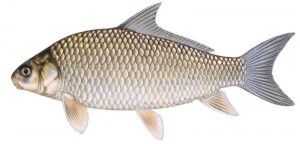River Redhorse

Species Details
Moxostoma Carinatum
Catostomidae
Cypriniformes
Rivers, Lakes, Backcountry
5 - 9 lbs.
23" - 28"
River Redhorse (Moxostoma carinatum) Fish Description
The River Redhorse is known under several names such as the big-sawed sucker, river mullet, greater redhorse, redfin redhorse, and redhorse sucker.
They are a beautiful species of good size. River redhorse has a brassy orange hue on the majority of their body, a pale olive backside, and a cream-colored underside. Their fins range from moderate to bright orange tone, and bright yellow streaks can be found occasionally on their anal fin.
The River redhorses’ heads are quite large, going about four times the standard length. And they have a big mouth, with strongly folded upper and lower lips.
The dorsal fin of the River redhorse averagely contains 12 to 14 soft rays, with its free margin being either straight or slightly concave. Their lateral line has around 42 to 47 scales, which have dark, crescent-like bases.
Diet and Size
River redhorses are bottom-feeders. Its diet commonly consists of mussels, snails, crustaceans, and small aquatic insects.
The weight of the River redhorses often ranges from 8 to 9 lbs., and grow at lengths up to 12 to 28 in.
Interesting Facts about River Redhorse
- They are excellent sportfish on their own, but also make a wonderful bait for other game fish, such as walleyes, trout, and muskies.
- Male River redhorses are responsible for constructing nests in clean gravel. They use their tails to sweep, and their mouths to carry rocks or move materials with their heads. Nests are measured to be 20-30cm in-depth, and around 1.2 to 2.4m across.
River Redhorse - Fishing Techniques
River redhorse fish are frequently found in clear, large creeks and rivers. And occasionally, in lakes as well. Anglers sometimes catch these fish using spearing or hook and line.
When caught using hook and line, typically crayfish or worms are chosen as bait. But other baits that can be used for fishing, like clams, shrimps, or even canned spam would work as well.
River redhorse fish are usually fished from the bottom, by either stationary means or with a bottom-bounce approach for their bait.
This Centerpin Float-fishing method could be your best friend here, as it works great with River redhorse fish, especially if the bait ever so brushes the bottom and follows downstream with the water current. So be sure to use small, sharp hooks with a decent weight so it can make some contact with the bottom if you’re going with this method.
But if you’re stationary fishing, try to prop your fishing rod on a bank stick, as the bites can be quite light and difficult to discern, so you can detect a bite better.
Waters with a good steady stream with clean sand, rock, or gravel bottoms are quality spots for River redhorse fish.
Habitat and Distribution
River redhorse is most commonly observed to inhabit medium to large rivers with significant flows. Adult River redhorse fish are found to migrate during May and June to shallow riffle-run habitats with a more coarse substrate and sizeable flows, away from their deeper, slower moving pools.
They are frequently found throughout areas in the central and eastern Mississippi River system, the Gulf Slope from Florida to Louisiana. This distribution extends further into the north, through the Great Lakes basins and St. Lawrence River. And they are well-known from 24 states, and also from provinces located in Quebec and Ontario.






